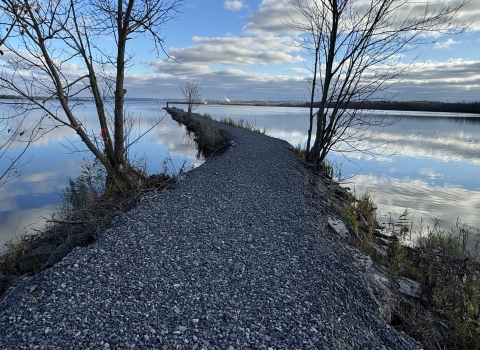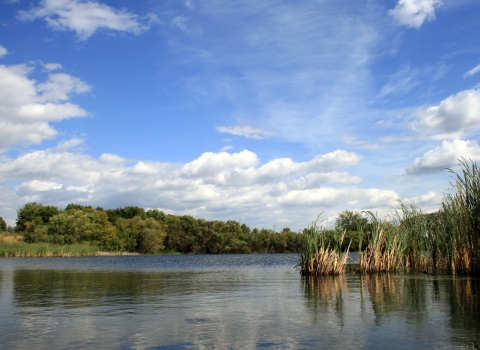PORTLAND, Ore. – The Pacific Northwest has another cause for celebration during the 50th anniversary of the Endangered Species Act. Today, the U.S. Fish and Wildlife Service announced the removal of Nelson’s checker-mallow, a perennial flower with spectacular pink blooms, from the federal list of endangered and threatened species due to recovery.
The delisting of Nelson’s checker-mallow is now the latest in a string of recent recoveries for federally listed Pacific Northwest plants. Golden paintbrush was delisted in July after a remarkable comeback, and Bradshaw’s lomatium was delisted due to recovery in 2022.
When Nelson’s checker-mallow was listed in 1993, most known populations were small and threatened by habitat loss, encroachment by invasive and woody plant species, and roadside management activities. Thanks to the work of a diverse network of partners, this species is now found at more than 50 locations and 38 independent populations have management plans protecting this plant and its habitat into the future.
“Recovering species is difficult but rewarding work, and we are fortunate to have dedicated partners who collaborated with us rose to the challenge to save the Nelson’s checker-mallow,” said Hugh Morrison, the Service’s Pacific Regional Director. “We are thrilled to announce the delisting of a second prairie plant during the 50th anniversary of the Endangered Species Act. This success story highlights the power of partnerships when it comes to conservation in the Pacific Northwest.”
This recovery and delisting of Nelson’s checker-mallow was possible due to the extensive efforts of partners committed to this plant’s conservation, including the Confederated Tribes of the Grand Ronde, private landowners, Institute for Applied Ecology, The Nature Conservancy, Greenbelt Land Trust, Native Plant Society, Oregon State University, Portland State University’s Rae Selling Berry Seed Bank, county and city governments, Oregon Department of Agriculture, Oregon Department of Fish and Wildlife, Oregon Department of Transportation, Oregon Department of Forestry, U.S. Army Corps of Engineers, Bureau of Land Management, and the Natural Resources Conservation Service.
Prairies are transient plant communities, requiring continued disturbance to prevent them from turning into woodlands. Prairie habitat loss and degradation in Oregon and Washington has been significantly reduced through years of habitat management and by the ongoing commitments from our conservation partners.
Landowners are actively maintaining prairies through mowing and prescribed burning, practices that mimic the natural disturbance processes needed to prevent native plant communities from turning into a forest or sea of annual invasive grasses. Many landowners are working with the Service’s Partners for Fish and Wildlife Program and local National Wildlife Refuges to improve and maintain prairie habitat on their lands, bringing our collective resources to the table.
Other native plants and pollinators are also benefitting from the extensive network of prairie partnerships in the Pacific Northwest. This includes the two recently delisted plants, golden paintbrush and Bradshaw’s lomatium, and currently ESA-listed species, such as Willamette daisy, Kincaid’s lupine, Taylor’s checkerspot butterfly, and Fender’s blue butterfly, the latter having recently been downlisted from endangered to threatened.
Since it was signed into law in 1973, more than 99% of all species listed under the law are still with us today. To date, more than 50 species have been delisted from the ESA due to recovery and more than 60 species have been downlisted from endangered to threatened. The ESA encourages innovative partnerships that conserve wildlife and their habitats across the country.
The delisting of Nelson’s checker-mallow will be effective 30 days from publication in the Federal Register. During a five-year monitoring period following the plant’s delisting, Service biologists will keep a close eye on plant populations to make sure that the species remains secure from the risk of extinction.
The U.S. Fish and Wildlife Service works with others to conserve, protect, and enhance fish, wildlife, plants and their habitats for the continuing benefit of the American people. For more information about our work and the people who make it happen, visit https://www.fws.gov/pacificor connect with us via Facebook, Twitter, YouTube and Flickr.
Frequently Asked Questions
What action is U.S. Fish and Wildlife Service taking?
The Service is removing Nelson’s checker-mallow from the federal list of threatened and endangered species due to recovery. The delisting of Nelson’s checker-mallow will be effective 30 days from publication in the Federal Register.
What is Nelson’s checker-mallow?
Nelson’s checker-mallow is a tall perennial herb in the mallow family with lavender to deep pink flowers. It blooms between May and July, but flowering may continue until early September, depending on conditions.
Where is the plant found?
Nelson’s checker-mallow lives in a variety of prairie habitats in the Willamette Valley and Coast Range of Oregon and in southwestern Washington. It grows along streams and in wet meadows, but can also be found along roadsides at stream crossings where non-native plants are also present.
What does the plant need to survive?
Nelson’s checker-mallow inhabits a variety of prairie habitats and soil types, but is typically found in open areas with little or no shade. In the Willamette Valley, the plant occasionally occurs in the understory of Oregon ash or among woody shrubs, but more frequently occupies small meadows, including those along sloughs, ditches, streams, roadsides, fencerows, drainage swales, and plowed fields. In the Coast Range, Nelson’s checker-mallow populations typically occur in open, wet to dry meadows, in intermittent stream channels, and along the edges of coniferous forests.
Why did the Service list Nelson’s checker-mallow as threatened in 1993?
The plant and its habitat faced a combination of threats including land development for agriculture, stream channel alteration that has limited the amount of water to meadow areas, recreational activities, and roadside spraying. Fire suppression practices also allowed for succession by introduced and native trees and shrubs that have taken over Nelson's checker-mallow habitat. Additionally, plans for the construction of a reservoir threatened the largest population of this species in the Coast Range.
Are there any threats this plant faces today?
Habitat loss, fragmentation, and degradation still occur on the landscape, but the extent of these threats has significantly decreased. Management and conservation efforts over the past 30 years have helped Nelson’s checker-mallow thrive. Partners will continue to actively manage prairie habitat through mowing and prescribed burning, providing the disturbance that is needed to prevent the encroachment of invasive grasses and woody plants.
Climate change may negatively impact Nelson’s checker-mallow in the foreseeable future by changing hydrological cycles, drying out this plant’s habitat. Detailed quantitative estimates of the effects of future climatic conditions on Nelson’s checker-mallow populations are not available.
How is this plant able to come off the list of threatened and endangered species?
The Recovery Plan for this species provided a strategy and goals, and recommended a roadmap of actions, that helped the Service and partners move the species move toward delisting; the delisting itself was done through a rule-making process that requires our analysis of specific listing factors. The Service recommended that the species no longer met the definition of a threatened species through our routine 5-year status review completed in 2021 (reviews are required for all listed species). We then proposed to delist the species through a public rule-making process. This process included a public comment period and publication of this final rule. The Service will also implement a post-delisting monitoring plan to ensure populations remain healthy and stable.
What efforts led to the recovery of Nelson’s checker-mallow?
The Service and a suite of partners have completed a variety of recovery measures over the past 30 years that have improved conditions for Nelson’s checker-mallow and other prairie species. Active maintenance of prairie habitat through mowing and prescribed burning has demonstrably reduced the threat posed by alteration of disturbance processes and associated woody encroachment. This active management has also significantly reduced the threat of invasive plants.
Range-wide, there are management plans for 38 of the more than 50 populations known to contain Nelson’s checker-mallow, and that number is expected to remain relatively constant into the foreseeable future. Sixty Nelson’s checker-mallow sites are in public ownership, have been acquired by non-governmental conservation organizations, or are enrolled in conservation easement conservation easement
A conservation easement is a voluntary legal agreement between a landowner and a government agency or qualified conservation organization that restricts the type and amount of development that may take place on a property in the future. Conservation easements aim to protect habitat for birds, fish and other wildlife by limiting residential, industrial or commercial development. Contracts may prohibit alteration of the natural topography, conversion of native grassland to cropland, drainage of wetland and establishment of game farms. Easement land remains in private ownership.
Learn more about conservation easement programs, which has substantially reduced the risk of habitat and population losses due to land use conversion.
Despite the continued presence of habitat-related threats on the landscape, these advances in site management and protection have led to a significant reduction in threats and overall improvement in the status of the species since listing.
What if Nelson’s checker-mallow populations decline again in the future?
The Service will work with our partners to monitor the species’ status for a period of 10 years following its delisting from the ESA to ensure populations remain healthy and viable. The details of this monitoring are provided in the post-delisting monitoring plan for the species. If the status of Nelson’s checker-mallow should significantly decline, the Service may reevaluate whether it warrants ESA protections.
What can I do to help Nelson’s checker-mallow continue to thrive?
The public can help by doing their best to help control the spread of invasive weeds. Easy ways to do this include brushing off your shoes before you head out for a hike or by helping with active removal of woody non-native invasive species invasive species
An invasive species is any plant or animal that has spread or been introduced into a new area where they are, or could, cause harm to the environment, economy, or human, animal, or plant health. Their unwelcome presence can destroy ecosystems and cost millions of dollars.
Learn more about invasive species such as blackberry or scotch broom. Local Soil and Water Conservation Districts can be a resource for information on controlling the spread of weeds.
Another way to help Nelson’s checker-mallow thrive is by planting native plants (flowering plants and bunchgrasses) to support pollinator populations, especially native bumble bees. Increased abundance and diversity of pollen, nectar, and habitat resources can support larger and more diverse pollinator communities. By supporting prairie plant communities, you can benefit other listed and at-risk plants and wildlife, such as butterflies.
Finally, because Nelson’s checker-mallow remains listed under state Endangered Species Acts in Oregon and Washington, the public can help by understanding and following each state’s regulations.



